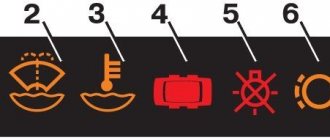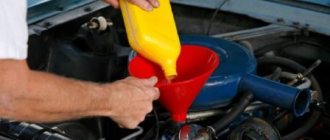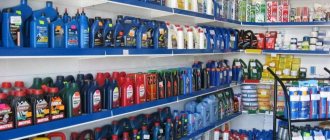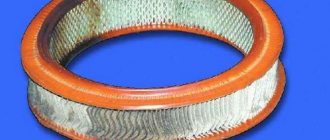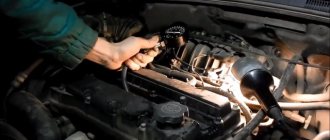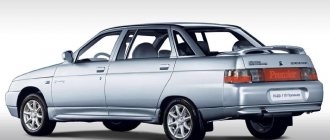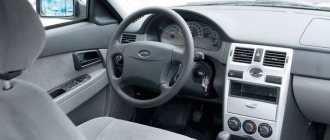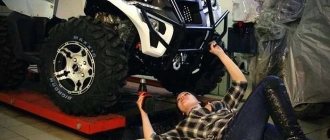A certain failure in the operation of the power unit is characterized by the concept of “the diesel engine has gone haywire.” Such a malfunction is more often a problem with diesel engines, although there have been cases when a gasoline carburetor engine was damaged.
This concept should be understood as an uncontrolled spontaneous increase in engine speed to the maximum permissible values, as a result of which the power unit actually self-destructs after several minutes of operation at the limit.
A similar operating mode can occur both after starting the engine and after a sharp reduction in the load on the engine. Diesel overrun means maximum speed (arrow in the red zone of the tachometer), loud noise during engine operation, which is accompanied by thick smoke and soot from the exhaust pipe, as well as sometimes flashes of flame.
We also recommend reading the article on how to decarbonize a diesel engine with your own hands. From this article you will learn about the causes and consequences of carbon deposits in the engine combustion chamber, as well as available methods for decoking piston rings and removing deposits from the surface of parts.
The consequences of runaway for an internal combustion engine are usually catastrophic: the engine overheats, then the unit jams as a result of overheating or destruction of parts due to increased mechanical loads, the crankshaft breaks, valves, pistons melt, etc. Running a diesel engine is also dangerous because the engine can literally explode, as the connecting rods pierce the cylinder head, break the cylinder block, and fragments fly into the engine compartment. A fire in the engine exhaust tract is also possible.
What to do if the diesel engine breaks down?
Do you know, friends, why diesel engines are called the devil's engines? No..? And what does Satan have to do with it, you ask? Here's the thing. The most common reasons for this rather biased attitude of some motorists towards this type of internal combustion engine (ICE) can be attributed to the specific nuances of its operation on diesel fuel (DF), which rumbles constantly during its operation, and also vibrates strongly and collects enough energy inside itself. a lot of soot emitted by a powerful engine from the depths of the exhaust pipe into the atmosphere. Note that recently these unpleasant nuances, once tightly associated with the diesel engines themselves, are gradually fading into the background. All modern diesel engines have now become much more environmentally friendly and have become very fond of the nature around us. However, there is another reason for this attitude of drivers and other citizens towards diesel engines. This is a certain factor that at some point they can seriously fail and go to pieces, and then everything will fall on the “card” at once, that is, your health and even human life! Therefore, this engine is considered by many citizen motorists to be “The True Satan!”
See also: Warming up a cold engine: An alternative opinion
You, friends, certainly may have once heard about such an unusual phenomenon as a diesel engine blowing up, and perhaps you yourself once had not the most pleasant moments of dealing with this phenomenon with a “frenzied diesel engine.” Although this is rare, it still happens (the further we move from the beginning of Rudolf Diesel’s creation of his first prototype, the less common this phenomenon is). But to say this for sure, many of you may never have the chance to encounter this phenomenon. Although, to our regret, this cannot be said one hundred percent today. So friends, let’s better be fully armed and together curb (at least) in theory this uncontrolled diesel engine.
We will try to tell you in as much detail as possible about the main point, what may cause such a problem and the risks associated with it, as well as how we can quickly put an end to this rapidly developing situation.
Everything you need to know about the Volkswagen scandal
Links
- engine spacing
- article from. - Seifert, Bill.
Offshore Sailing: 200 Essential Passagemaking Tips. —McGraw-Hill Professional, 2001.
Compression ratio of a diesel engine - what is it?
A diesel engine (in common parlance - diesel) is a piston internal combustion engine that operates on the principle of self-ignition of atomized fuel under the influence of air heated during compression. It is used mainly on ships, diesel locomotives, buses and trucks, tractors, diesel power plants, and by the end of the 20th century it became widespread on passenger cars. Named after the inventor. The first engine operating on this principle was built by Rudolf Diesel in 1897.
The range of fuels for diesel engines is very wide, this includes all fractions of oil refining from kerosene to fuel oil and a number of products of natural origin - rapeseed oil, frying fat, palm oil and many others. A diesel engine can also run on crude oil with some success.
The MiG-31 (according to NATO codification: Foxhound - fox hound) is a Soviet and Russian two-seat supersonic high-altitude all-weather long-range fighter-interceptor. Developed at OKB-155 (now PJSC RSK MiG) in the 1970s. The first Soviet combat aircraft of the fourth generation.
The MiG-31 is designed to intercept and destroy air targets at extremely low, low, medium and high altitudes, day and night, in simple and adverse weather conditions, when the enemy uses active and passive radar jamming, as well as false thermal targets. A group of four MiG-31 aircraft is capable of controlling airspace with a frontal length of up to 1,100 km.
Initially, the fighter was developed to intercept aircraft cruise missiles and the then new American B-1 bombers in the entire range of altitudes and speeds, as well as low-flying satellites and automatic drifting balloons (ADA), launched by NATO countries since the 50s over the territory of the USSR.
For several years, the MiG-31 regiments had the status of special forces (SpN) as part of the air defense.
Engine knock occurs during rapid (explosive) combustion of the fuel-air mixture in the cylinder of an internal combustion engine. To the ear it is perceived as a metallic “ringing” or knocking. This is an undesirable mode of engine operation, since increased pressure and overheating occur in the cylinder, and the cylinder structural elements experience increased loads for which they were not designed, engine power decreases, and emissions of harmful substances increase. When intensely applied, these loads quickly lead to cylinder damage and engine failure.
Engine knocking is sometimes called detonation or detonation combustion of the mixture, but this name does not reflect the physics of the phenomenon. Combustion of the mixture in an engine cylinder, both when ignited by a spark and during premature self-ignition of the mixture in hot spots, as a rule, is not accompanied by the formation of detonation waves. In accordance with the amplitude of the pressure waves that occur in the cylinder during rapid combustion of the mixture, a distinction is made between the normal combustion mode (without knocking) and the mode in which knocking occurs. The latter mode, in turn, is divided into conventional knock of varying intensity and detonation knock (super-knock or deto-knock) according to peak pressure values. Detonation knock is especially undesirable, since the pressure generated in the detonation combustion wave can immediately destroy the cylinder.
The occurrence of knocking is associated with the effects of abnormal combustion of the mixture in the cylinder: self-ignition of the mixture before it is ignited by a spark or wall ignition by hot structural elements or foreign particles in the cylinder. The likelihood of knocking increases with increasing compression ratio and engine load, as well as with decreasing fuel octane number. Electronic ignition control systems are used to prevent knocking, and anti-knock additives such as MMA (monomethylaniline) or MTBE (methyl tert-butyl ether) are added to the fuel.
Characteristic
Sometimes you hear “diesel has gone bad.” What does it mean? Overrun is an uncontrolled increase in engine crankshaft speed, regardless of the position of the accelerator pedal. In most cases, the driver cannot control this process. The crankshaft rotates at high speed, which is constantly increasing.
Sometimes the revs reach 5 thousand. This is dangerous for a diesel engine. This action occurs for several minutes. The result is a jammed power unit. Often accompanied by thick black smoke from the exhaust pipe.
Reasons – fuel injection pump
One of the main reasons for this phenomenon is a malfunction of the high-pressure fuel pump or rack. As a result, fuel enters the combustion chamber without restrictions. This is an uncontrolled process. And the more of it gets into the chamber, the higher the engine speed. After this, the gas distribution mechanism (often with a chain drive) does not have time to react to these changes. As a result of incorrect phase distributions, the crankshaft, intake and exhaust valves bend. The consequences in most cases are very sad. What to do if the engine breaks down?
There is only one way to save the unit - shut it down. But it is not always possible to do this with a key. You have to independently block the access of air to the combustion chamber. But in some cases, the diameter of the inlet intake hole is very large. And even with improvised means it will not be possible to close it. Air will still flow through small cracks. It is worth noting that on passenger cars the oxygen intake is located at the bottom. Therefore, you will have to cut off the supply after the air filter. To do this, unscrew the clamp with a screwdriver and stop the oxygen supply to the pipe. This needs to be done as quickly as possible. Remember that minutes count here. The second option is longer, but effective. If the engine starts to spin, it is necessary to stop the fuel supply by disconnecting the fuel line. But there is not always time for this. The consequences are bent valves and a failed crankshaft. The worst thing is that at this time fragments of the cylinder block are flying. The explosion can be compared to the effect of a grenade. It is simply dangerous to be near such a motor. But this does not happen immediately, but after 3-5 minutes of engine operation in this mode.
Turbine
Diesel can go bad for a variety of reasons. If it is a turbocharged engine, there is a high probability that this happened precisely because of this mechanism. This element is cooled by oil. Sometimes leaks occur. As a result, the mechanism is unable to provide boost. Engine speed involuntarily increases. As they increase, the oil pump begins to pump lubricant faster. As a result, it ends up in the combustion chamber. Black smoke comes out of the exhaust pipe.
With such a malfunction, the unit may be left without lubrication altogether. After all, all the oil went into the exhaust pipe. There have been cases when, even after turning off the fuel supply, the unit continued to operate purely on lubricant. And even if this process lasts no more than a minute, this is quite enough for the diesel to go to waste. This happens especially often on older military engines. They are designed for the consumption of fuel oil and kerosene. Therefore, you should not be surprised that after stopping the fuel supply, the engine continues to work. If the diesel engine goes into overdrive, the crankshaft may burst in half. It is not necessary that it will tear out the cylinder block and fly out with fragments. In some cases, the engine will continue to operate, but with characteristic knocking noises. What else happens when diesel goes into overdrive? As the speed increases, the engine temperature increases. It overheats quickly. Also, if it is a leak from the turbine, fires are possible in the exhaust manifold area. Piston jamming occurs in a matter of minutes
Moreover, it does not matter what the current inertia force of the flywheel is. Even if the car is idling, the connecting rod bolts and other elements of the crank mechanism (crank mechanism) may break.
What is diesel engine runaway?
First, a short note. -When a diesel engine goes into overdrive, this means that its speed begins to increase extremely quickly and uncontrollably and goes beyond the red line on the tachometer. At this moment, extraneous noise, black smoke, soot appear, and sometimes flames can be emitted, and all this at the same time, as a “bonus,” comes straight out of the exhaust pipe.
Why only diesels?
As practice shows, only the diesel engine is destroyed.
And there are reasons for this. The speed of a gasoline engine is controlled by the throttle valve. It passes a certain amount of air, as a result of which the number of shaft revolutions can be adjusted from 1 to 7 thousand. On gasoline motorcycle internal combustion engines, the maximum mark is 10-13 thousand. As for the diesel engine, its operation is controlled by the amount of fuel, not air. The design of such a unit does not have a throttle valve. Moreover, in order to ignite the mixture, it does not need candles or sparks. Even if you remove the battery, such a motor will continue to work. As for modern diesel engines, they have a much smaller chance of going into overdrive, since the amount of fuel is strictly dosed by injectors.
Here the system is controlled electronically, so if there are problems with the gas pedal, the computer will stop or partially reduce the supply of fuel to the combustion chamber. This usually takes less than a second. Thus, if the diesel goes into overdrive, you do not have to unscrew the fittings and lines yourself, or block the access to oxygen. The electronics will do everything for you, and so quickly that you won’t notice it.
Additional pump adjustment
If diagnostics of diesel engines shows that the mixture is not being prepared correctly, most likely the cause is the injection pump, and the centrifugal regulator cannot cope with this function. For this, a special adjustment stand is used.
Before checking, it is necessary to clean the pump from dirt and other deposits. Then the injection advance is checked using marks and the low pressure valve is diagnosed. To do this, you need to unscrew the valve and tap with a hammer (light blows) on its upper part. Next, the cyclic feed is set. It is adjusted using a locknut. If necessary, it is unscrewed or tightened and then clamped. Normal idle speed of a diesel engine is 770-790 per minute. For additional adjustment, use a hydraulic corrector by rotating its rod counterclockwise or clockwise. Timely troubleshooting ensures reliable operation of the power system and the engine as a whole.
What to do if the diesel engine goes bad
The most correct decision would be to completely abandon attempts to turn off the engine, which has gone to pieces. We should not forget that engine breakdown often ends in a split of the cylinder block and/or cylinder head. As a result of such damage, fragments fly away at high speed, which is a threat to life.
The danger of engine overrunning lies in the fact that the driver does not always have time to notice in a timely manner the beginning of an uncontrolled increase in speed. If the diesel engine has just started to run out in a car that is standing still, then you can try to turn off the engine.
Diesel runaway in motion is an emergency. In this case, concern about the condition of the engine takes a back seat to the risk of getting into a serious accident. The fact is that the car will begin to accelerate immediately and sharply. In such a situation on the road, the main thing to remember is that the diesel engine wear only lasts a few minutes. The primary task is to take counter-emergency measures.
If you nevertheless decide to try to save a diesel engine that has gone to pieces, then there are two ways:
- turn off the air supply;
- stop fuel supply;
The simplest solution is to cut off the air supply with improvised objects. You need to plug the air duct in the air filter area. It must be separately taken into account that at the time of engine separation the temperature under the hood is extremely high, so there is always a risk of burns, injuries or fire.
The second option is the method of disconnecting the fuel supply line/pipes, which also requires experience, knowledge of the internal combustion engine structure and extreme caution. If you are not confident in your abilities, then it is better not to open the hood and completely abandon any attempts to turn off the engine, moving away from the car to a safe distance.
To summarize, it should be added that often there is not enough time to stop the supply of air or fuel to the cylinders in a timely manner. Car owners simply do not have time to prevent jamming or destruction of the internal combustion engine.
Diagnostics of diesel engine faults
As mentioned earlier, the engine can spin out immediately after starting or after a sharp reduction in load. You can diagnose the malfunction using the tachometer: the idle speed will not be at a normal level. In addition, a sharp engine hum will appear, accompanied by increased emissions of black exhaust smoke.
As for driving in gear, the car will begin to pick up speed very quickly on its own. It is worth saying here that this behavior of the machine is extremely dangerous, and therefore it is necessary to take quick and decisive measures.
First of all, put the car in neutral and stop the car on the side of the road. It will be better if it is a deserted place so as not to pose a danger to others. Next you need to stop the engine. If the engine has gone into overdrive, then it will not be possible to do this in the usual way, so you need to get out of the car and forcefully turn off the engine. To do this, you can cut the fuel pipes. Thus, the fuel supply will stop and the engine will stop. The pipes are located on the gas tank or fuel rail under the hood. Which ones to chop is your choice, but it should be based on the speed of your actions.
Another way is “oxygen starvation.” It is necessary to remove the air filter, or without removing it, plug the air pipe with thick fabric or any other material. Thus, air will stop flowing into the combustion chamber and the engine will stop. Further movement is possible only in tow. Unfortunately, it is impossible to move on such an engine.
How to avoid malfunction?
To avoid serious consequences, you need to monitor the performance of the injection pump.
An engine equipped with a turbine or compressor should not squirt oil or “eat” it beyond normal limits. The limit is 1 liter per ten thousand kilometers. Timely oil changes and repairs to the cylinder-piston group can reduce the risk of blowout several times. Remember that if the seal is broken, oil will enter the intake tract along with air. This mixture burns much more intensely. Therefore, the turnover will increase. And so on until the oil is completely gone. Crankcase ventilation should also be monitored. If it is poorly sealed, oil vapors enter the intake manifold. When the car's mileage is high, the piston rings are not able to remove all the film. As a result, vapors under pressure from the crankcase penetrate into the combustion chamber. It is impossible to control this process.
Reasons for separation [edit | edit code]
There are three main reasons for diesel engine breakdown: a malfunction of the high-pressure fuel pump, a large amount of oil entering the combustion chamber through a faulty turbocharger, and a malfunction of the injectors. Electric motors run out when there is a sudden loss of load, a malfunction of the control system, or a malfunction of the independent excitation windings.
Malfunction of the high pressure fuel pump [ edit | edit code]
Unlike gasoline engines, in which the supply of the fuel-air mixture to change engine power and speed is controlled by the throttle valve, diesel engines are controlled by changing the amount of fuel supplied by the high-pressure fuel pump (HPF) to the combustion chamber. The fuel injection pump is driven by the camshaft, and its performance directly determines the engine rotation speed. To maintain a given speed, a centrifugal regulator is used, which limits the injection volume as the rotation speed increases. If the injection pump rack is jammed, the negative feedback circuit is broken, as a result of which the engine, depending on the position of the regulator, can either stall due to insufficient fuel or go into overdrive.
Oil capture[edit | edit code]
In most vehicles, the crankcase ventilation is routed into the intake manifold. On a severely worn engine, gases break through the piston walls from the combustion chamber into the crankcase, pick up oil mist from the crankcase and carry it into the intake manifold. A diesel engine can run on motor oil because it contains even more chemical energy than standard diesel fuel, causing the engine speed to rise. As a result of an increase in speed, the amount of oil mist captured from the crankcase also increases, and a positive feedback is formed. Such diesel runaway is even more dangerous, since the amount of oil mist picked up turns out to be sufficient to operate without any fuel supply at all, and the speed increases uncontrollably, since all standard control methods affect the supply from the fuel injection pump, which leads to serious accidents. To protect against operation on oil, some diesel engines (automotive YaAZ-204, heavy D49, installed on diesel locomotives, ships, mobile power plants, etc.) have an air flap installed in the intake tract, which closes upon a signal from the limit switch.
A diesel engine can also go into overdrive if the piston burns out or if the turbine malfunctions (destruction of the shaft seals or fracture of the shaft itself). In this case, oil accumulates in the intercooler, which is not always remembered during repairs - as a result, the repaired engine can again go into disarray. Unwanted engine oil can also enter the intake manifold from leaking turbocharger seals, excessive oil levels in the crankcase, or other mechanical problems. In vehicles or stationary applications that use gas-diesel engines that consume natural gas, gas leakage can also lead to carryover due to its entry into the engine air intake [3] . A similar problem exists in places containing coal dust, so all machines with diesel engines operating in coal mines must have a coal dust filter.
Electric motor separation [ edit | edit code]
Runaway can only occur with commutator electric motors. For synchronous and asynchronous motors, the rotation speed is always limited by the frequency of the supply current, and for brushless motors - by the control electronics. Occurs with a sudden loss of load: destruction of the mechanical transmission (cutting off the drive key, breakage of the drive belt), slipping of the wheels (on locomotives), rupture of the stream of pumped liquid (on electric pumps).
What not to do?
Five years ago, we published a review article about diesel engine spacing: Diesel engine spacing. The essence of the phenomenon, how to avoid it and how to stop it? We recommend that you familiarize yourself with it. So, it gave examples of how you can turn off the engine in two other ways. Then we warned that the options could be quite dangerous for inexperienced car owners. We repeat today: you shouldn’t get under the hood if you are not a mechanic or don’t know exactly what and how to do.
Got into trouble
Examples of the use of the word peddling in literature.
Of course, the ball in the Mabille garden is not the Polymnian dances on the Janiculum Hill, but the haberdashery peddler is stalking the lorette there, just like Staphilus's pimp, the virgin Planesia.
Willis and Zimmer turned off the engine, which had gone haywire, and P.G. began lowering the rocking helicopter, glad that they had only climbed fifty feet.
Seeing, however, that the noblewoman was not angry, Demid spoke more briskly: “A small merchant often peddles his trade from a German.”
Then the moment comes when the Executor realizes that all his desires are coming true - and, one might say, he walks away, intoxicated with his own power.
Yes, and all trade from the Germans goes through us, and in the volosts we also sell German goods ourselves!
They also include peddlers, day laborers, small businessmen and company managers, as well as successful, very wealthy entrepreneurs.
Ten years ago I was peddling and carrying a suitcase from house to house.
During the war, he was a peddler, even without a patent, a tramp, illegally selling textile goods, a small speculator, wandering from village to village, either by train or on foot, walking kilometer after kilometer of country roads, through dense forests to remote farms, with a dirty leather bag behind his shoulders, or even with a basket or dilapidated suitcase in his hand.
Finally I heard my heart begin to pound decisively, the blood rushed to my face, and sweat appeared.
In most cases, the rockets exploded from the bottom and side of the engines, the destroyed turbine and compressor went wild and the blades flying in all directions chopped up everything in their path worse than shrapnel.
This incident had tragic consequences - while going on a control flight after repairs, Major Kozovoy came under fire from the DShK, the tail rotor with a shot off blade went haywire, the damaged tail boom collapsed, and the out-of-control vehicle collapsed, burying the entire crew.
The reasons were in Moscow, as Mikhalych explained, wincing, after reading out the order about the failure of the next Panjshir operation, that the civilians were peddling the military machine.
Ipat left the hospital earlier and went to the front again, and Nikon, having met October in Moscow, decided to save some money before returning to the village and took up peddling.
At the beginning of the next summer, when she was again blissfully jogging through the Ilyichevsk hills and forests, Denis and Anton were filming location in the Baltic States, her mother-in-law was in the hospital, and Philip, instead of going crazy in an empty apartment, suddenly became interested in radio engineering and became make decent money by turning your room into a workshop.
The most unpleasant thing that can happen on a nuclear ship happened - the reactor went haywire, approaching an uncontrolled regime, which naturally culminates in a super-powerful explosion.
He went wild
What should you do after you have stopped the diesel engine?
Even when you did everything correctly and quickly stopped the engine, try NOT to START it again under any circumstances. If this problem catches you on the road, then park your car in a safe place, turn on the emergency lights and call a tow truck. You need to take the car to a car service center, where they will study the situation in detail and determine the cause of the illness.
If your car is parked in the middle of the road and is interfering with the passage of other vehicles, then anyway, take your time and set it to the hazard lights, or better yet, try to roll it to the side of the road WITHOUT STARTING THE ENGINE!
Our video clip above clearly shows everything that can happen when an engine runs out of control, and also how some experienced motorists were able to stop an out of control engine. And friends, there is one more precaution that we want to inform you about, namely, if you try to stop the air supply to the engine directly through the turbocharger (as the American did and as shown in the second video), then please be extremely careful not to accidentally get your fingers into the turbine rotor!
Action plan in case of engine malfunction
Many motorists have already developed a specific action plan that is recommended to be carried out in the event of equipment breakdown.
- If for some reason the engine speed begins to increase sharply, then it is necessary to turn off the ignition and gear. Very often the driver does not always have time to notice the increase in speed. At the initial stage of their growth, it is possible to turn off the engine in the usual way.
- If possible, move to the side of the road;
- If necessary, open the hood to gain access to the air intake;
- It is recommended to turn on the hazard lights;
- The air intake hole must be covered with thick cloth. Truckers use sweatshirts for these purposes. If there is a carbon dioxide fire extinguisher in the car, then use it. The jet is directed into the air intake. Since this gas is not flammable, the powerful flow will cause the engine to “choke,” which will lead to its stop;
- You can no longer start the engine. Otherwise, the car owner will see his engine die. The car is transported to the repair shop either by tow or by tow truck.
If for some reason the driver cannot perform these manipulations, then he should move a short distance from the car and start calling specialized services for help.
If you carry out the above steps in time, this will lead to the fact that only engine repair will be required, and possibly replacement of the turbocharger. However, there will be no other serious consequences.
Experts do not recommend repairing equipment on your own, because the slightest flaw will lead to the situation with the breakdown repeating. It is best to repair a diesel engine in specialized centers. Therefore, you should not skimp on the work of professionals, so as not to pay twice.
Reason for separation
There are two reasons for engine runaway:
- The main reason for diesel engine runaway is the uncontrolled, independent entry into the intake manifold of liquids that can independently ignite in the engine cylinders. The most common contamination is motor oil;
- High pressure fuel pump malfunction. This is common on older manual cars. The fuel pump is responsible for supplying fuel in precise doses. A centrifugal regulator in the system is required to ensure that the motor maintains strictly the required speed. If the crankshaft begins to rotate more often, the fuel supply is limited using the regulator. With an increase in speed, there is an increased supply of fuel by the pump, which fills the cylinders. As a result, the maximum speed begins, and the engine goes into overdrive.
Let's take a closer look at why the engine is running wild? At the moment foreign liquids enter, when the spread process begins, it is very difficult to turn off the engine. Even if you forcibly shut off the fuel supply, oil continues to flow into the engine while it is rotating. And the engine will rotate as long as the oil is supplied.
That is, a vicious circle occurs. This circle can only be broken by engine destruction due to critical high speeds, or oil starvation.
In a diesel engine, the mixture of fuel and air is ignited not by a random spark, but by the degree of compression and high temperatures.
If you do not stop the operation of the equipment in a timely manner and correctly, this will lead to complete destruction literally within a few minutes.
